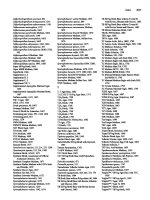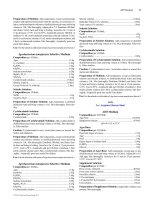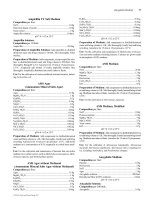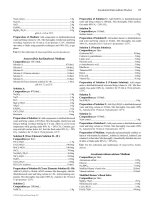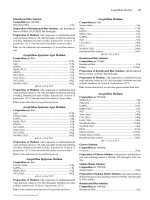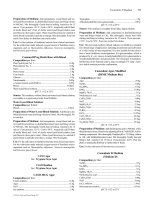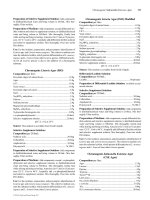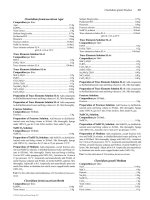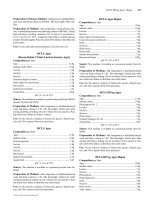Handbook of Microbiological Media, Fourth Edition part 13 doc
Bạn đang xem bản rút gọn của tài liệu. Xem và tải ngay bản đầy đủ của tài liệu tại đây (210.15 KB, 10 trang )
Ancalomicrobium adetum Medium 115
Yeast extract 5.0g
Na
2
CO
3
3.0g
NaCl 2.0g
K
2
HPO
4
1.0g
MgSO
4
·7H
2
O 0.2g
pH 6.5 ± 0.2 at 25°C
Preparation of Medium: Add components to distilled/deionized
water and bring volume to 1.0L. Mix thoroughly. Gently heat and bring
to boiling. Autoclave for 15 min at 15 psi pressure–121°C. Distribute
into tubes or flasks using anaerobic techniques and 100% CO
2
as gas
phase.
Use: For the cultivation of Anaerospirillum succiniciproducens.
Anaerovibrio burkinabensis Medium
Composition per 1011.0mL:
Solution A 870.0mL
Solution C 100.0mL
Solution D 10.0mL
Solution E (Vitamin solution) 10.0mL
Solution F 10.0mL
Solution G 10.0mL
Solution B (Trace elements solution SL-10) 1.0mL
pH 6.8–7.2 at 25°C
Solution A:
Composition
per 870.0mL:
Na
2
SO
4
3.0g
NaCl 1.0g
KCl 0.5g
MgCl
2
·6H
2
O 0.4g
NH
4
Cl 0.3g
KH
2
PO
4
0.2g
CaCl
2
·2H
2
O 0.15g
Resazurin 1.0mg
Preparation of Solution A: Add components to distilled/deionized
water and bring volume to 870.0mL. Mix thoroughly. Gently heat and
bring to boiling. Continue boiling for 3–4 min. Allow to cool to room
temperature while gassing under 80% N
2
+ 20% CO
2
. Continue gas-
sing until pH reaches below 6.0. Seal the flask under 80% N
2
+ 20%
CO
2
. Autoclave for 15 min at 15 psi pressure–121°C.
Solution B (Trace Elements Solution SL-10 ):
Composition
per liter:
FeCl
2
·4H
2
O 1.5g
CoCl
2
·6H
2
O 190.0mg
MnCl
2
·4H
2
O 100.0mg
ZnCl
2
70.0mg
Na
2
MoO
4
·2H
2
O 36.0mg
NiCl
2
·6H
2
O 24.0mg
H
3
BO
3
6.0mg
CuCl
2
·2H
2
O 2.0mg
HCl (25% solution) 10.0mL
Preparation of Solution B (Trace Elements Solution SL-10):
Add FeCl
2
·4H
2
O to 10.0mL of HCl solution. Mix thoroughly. Add dis-
tilled/deionized water and bring volume to 1.0L. Add remaining com-
ponents. Mix thoroughly. Gas under 100% N
2
. Autoclave for 15 min at
15 psi pressure–121°C.
Solution C:
Composition
per 100.0mL:
NaHCO
3
5.0g
Preparation of Solution C: Add NaHCO
3
to distilled/deionized
water and bring volume to 100.0mL. Mix thoroughly. Filter sterilize.
Gas under 80% N
2
+ 20% CO
2
.
Solution D:
Composition
per 10.0mL:
Sodium lactate 2.5g
Preparation of Solution D: Add sodium lactate· to distilled/deion-
ized water and bring volume to 10.0mL. Mix thoroughly. Gas under
100% N
2
. Autoclave for 15 min at 15 psi pressure–121°C.
Solution E (Vitamin Solution):
Composition
per liter:
Pyridoxine·HCl 10.0mg
Calcium DL-pantothenate 5.0mg
Lipoic acid 5.0mg
Nicotinic acid 5.0mg
p-Aminobenzoic acid 5.0mg
Riboflavin 5.0mg
Thiamine·HCl 5.0mg
Biotin 2.0mg
Folic acid 2.0mg
Vitamin B
12
0.1mg
Preparation of Solution E (Vitamin Solution): Add compo-
nents to distilled/deionized water and bring volume to 1.0L. Mix thor-
oughly. Gas under 100% N
2
. Autoclave for 15 min at 15 psi pressure–
121°C.
Solution F:
Composition
per 10.0mL:
Na
2
S·9H
2
O 0.4g
Preparation of Solution F: Add Na
2
S·9H
2
O to distilled/deionized
water and bring volume to 10.0mL. Mix thoroughly. Gas under 100%
N
2
. Autoclave for 15 min at 15 psi pressure–121°C.
Solution G:
Composition
per 10.0mL:
Yeast extract 1.0g
Preparation of Solution F: Add yeast extract to distilled/deionized
water and bring volume to 10.0mL. Mix thoroughly. Gas under 100%
N
2
. Autoclave for 15 min at 15 psi pressure–121°C.
Preparation of Medium: Aseptically and anaerobically combine so-
lution A with solution B, solution C, solution D, solution E, solution F, and
solution G, in that order. Mix thoroughly. Anaerobically distribute into ster-
ile tubes or flasks under 80% N
2
+ 20% CO
2
.
Use: For the cultivation and maintenance of Anaerovibrio burkin-
abensis.
Ancalomicrobium adetum Medium
Composition per liter:
Ammonium sulfate 0.25g
Glucose 0.25g
Na
2
HPO
4
71.0mg
Modified Hutner’s basal salts 20.0mL
Vitamin solution 10.0mL
Modified Hutner’s Basal Salts:
Composition
per liter:
MgSO
4
·7H
2
O 29.7g
Nitrilotriacetic acid 10.0g
CaCl
2
·2H
2
O 3.34g
FeSO
4
·7H
2
O 99.0mg
© 2010 by Taylor and Francis Group, LLC
116 Ancalomicrobium Medium
Ammonium molybdate 9.25mg
Metals “44” 50.0mL
Preparation of Modified Hutner’s Basal Salts: Dissolve the
nitrilotracetic acid first and neutralize the solution with KOH. Add oth-
er components and adjust the pH to 7.2 with KOH or H
2
SO
4
. There
may be a slight precipitate. Store at 5°C.
Metals “44”
Composition
per 100.0mL:
ZnSO
4
·7H
2
O 1.1g
FeSO
4
·7H
2
O 0.5g
CuSO
4
·5H
2
O 0.04g
EDTA 0.25g
MnSO
4
·7H
2
O 0.154g
Co(NO
3
)
2
·6H
2
O 0.025g
Na
2
B
4
O
7
·10H
2
O 0.018g
Preparation of Metals “44”: Add components to distilled/deion-
ized water and bring volume to 100.0mL. Mix thoroughly. Autoclave
for 15 min at 15 psi pressure–121°C. Add aseptically to sterile modi-
fied Hutner’s basal salts solution.
Vitamin Solution:
Composition
per liter:
Thiamine HCI 5.0g
Calcium
DL-pantothenate 5.0mg
Nicotinamide 5.0mg
Riboflavin 5.0mg
Biotin 2.0mg
Folic acid 2.0mg
Vitamin B
12
0.1mg
Preparation of Vitamin Solution: Add components to distilled/de-
ionized water and bring volume to 1.0L. Mix thoroughly. Filter sterilize.
Preparation of Medium: Add components, except modified Hut-
ner’s basal salts solution and vitamin solution, to distilled/deionized
water and bring volume to 970.0mL. Mix thoroughly. Autoclave for 15
min at 15 psi pressure–121°C. Aseptically add 20.0mL of modified
Hutner’s basal salts solution and 10.0mL of sterile vitamin solution.
Mix thoroughly. Aseptically distribute into sterile tubes or flasks.
Use: For the cultivation of Ancalomicrobium adetum.
Ancalomicrobium Medium
Composition per liter:
Glucose 0.25g
(NH
4
)
2
SO
4
0.25g
Na
2
HPO
4
0.071g
Hutner's basal salts solution 20.0mL
Vitamin solution 10.0mL
pH 7.0 ± 0.2 at 25°C
Hutner’s Basal Salts Solution:
Composition
per liter:
MgSO
4
·7H
2
O 29.7g
Nitrilotriacetic acid 10.0g
CaCl
2
·2H
2
O 3.335g
FeSO
4
·7H
2
O 99.0mg
(NH
4
)
6
MoO
7
O
24
·4H
2
O 9.25mg
"Metals 44" 50.0mL
"Metals 44":
Composition
per 100.0mL:
ZnSO
4
·7H
2
O 1.095g
FeSO
4
·7H
2
O 0.5g
Sodium EDTA 0.25g
MnSO
4
·H2O 0.154g
CuSO
4
·5H
2
O 39.2mg
Co(NO
3
)
2
·6H
2
O 24.8mg
Na
2
B
4
O
7
·10H
2
O 17.7mg
Preparation of Metals “44”: Add sodium EDTA to distilled/de-
ionized water and bring volume to 90.0mL. Mix thoroughly. Add a few
drops of concentrated H
2
SO
4
to retard precipitation of heavy metal
ions. Add remaining components. Mix thoroughly. Bring volume to
100.0mL with distilled/deionized water.
Preparation of Hutner’s Basal Salts Solution: Add nitrilotria-
cetic acid to 500.0mL of distilled/deionized water. Adjust pH to 6.5
with KOH. Add remaining components. Add distilled/deionized water
to 1.0L. Adjust pH to 6.8. Filter sterilize.
Vitamin Solution:
Composition
per liter:
Calcium DL-pantothenate 5.0mg
Nicotinamide 5.0mg
Riboflavin 5.0mg
Thiamine·HCl 5.0mg
Biotin 2.0mg
Folic acid 2.0mg
Cyanocobalamin 0.1mg
Preparation of Vitamin Solution: Add components to distilled/
deionized water and bring volume to 1.0L. Mix thoroughly. Filter ster-
ilize.
Preparation of Medium: Add components, except Hutner's basal
salts solution and vitamin solution, to distilled/deionized water and
bring volume to 970.0mL. Mix thoroughly. Adjust pH to 7.0. Auto-
clave for 15 min at 15 psi pressure–121°C. Aseptically add 20.0mL of
sterile Hutner's basal salts solution and 10.0mL of sterile vitamin solu-
tion. Mix thoroughly. Aseptically distribute into sterile tubes or flasks.
Use: For the cultivation of Ancalomicrobium adetum.
Ancylobacter/Spirosoma Agar
Composition per liter:
Agar 20.0g
Glucose 1.0g
Peptone 1.0g
Yeast extract 1.0g
pH 6.8 ± 0.2 at 25°C
Preparation of Medium: Add components to distilled/deionized
water and bring volume to 1.0L. Mix thoroughly. Adjust pH to 6.8.
Gently heat and bring to boiling. Distribute into tubes or flasks. Auto-
clave for 15 min at 15 psi pressure–121°C. Pour into sterile Petri dishes
or leave in tubes.
Use: For the cultivation of Ancylobacter aquaticus, Ancylobacter spe-
cies, Aquaspirillum metamorphum, Aquaspirillum serpens, Flectoba-
cillus major, Methylobacterium mesophilicum, Runella slithyformis,
Shewanella putrefaciens, and Spirosoma linguale.
Ancylobacter Spirosoma Medium
(DSMZ Medium 7)
Composition per liter:
Agar 15.0g
Glucose 1.0g
© 2010 by Taylor and Francis Group, LLC
Anderson’s Marine Medium 117
Peptone 1.0g
Yeast extract 1.0g
pH 7.1 ± 0.2 at 25°C
Preparation of Medium: Add components to distilled/deionized
water and bring volume to 1.0L. Mix thoroughly. Gently heat and bring
to boiling. Distribute into tubes or flasks. Autoclave for 15 min at 15
psi pressure–121°C. Pour into sterile Petri dishes or leave in tubes.
Use: For the cultivation and maintenance of Spirosoma linguale.
Andersen’s Pork Pea Agar
Composition per 1685.0mL:
Agar 16.0g
Peptone 5.0g
Pancreatic digest of casein 1.6g
K
2
HPO
4
1.25g
Soluble starch 1.0g
Sodium thioglycolate 0.5g
Pork infusion 800.0mL
Thioglycolate agar 660.0mL
Pea infusion 200.0mL
NaHCO
3
solution 25.0mL
pH 7.2 ± 0.2 at 25°C
Pork Infusion:
Composition
per liter:
Pork, fresh lean ground 454.0g
Preparation of Pork Infusion: Add ground pork to distilled/de-
ionized water and bring volume to 1.0L. Autoclave for 60 min at 0 psi
pressure–100°C. Filter through two layers of cheesecloth. Cool to 4°C.
Skim fat from surface. Warm to 25°C. Centrifuge at 5000 rpm for 10
min. Discard pellet.
Pea Infusion:
Composition
per 450.0mL:
Green peas, fresh or frozen 454.0g
Diatomaceous earth (celite) 10.0g
Preparation of Pea Infusion: Add green peas to 450.0mL of dis-
tilled/deionized water. Blend until smooth. Autoclave for 60 min at 0
psi pressure–100°C. Centrifuge at 5000 rpm for 10 min. Discard pellet.
Clarify supernatant solution with diatomaceous earth (celite). Filter
through Whatman #4 filter paper. Use filtrate solution.
Thioglycolate Agar:
Composition
per liter:
Agar 20.75g
Pancreatic digest of casein 15.0g
Glucose 5.5g
Yeast extract 5.0g
NaCl 2.5g
L-Cystine 0.5g
Sodium thioglycolate 0.5g
Resazurin 1.0mg
pH 7.1 ± 0.2 at 25°C
Preparation of Thioglycolate Agar: Add components to dis-
tilled/deionized water and bring volume to 1.0L. Mix thoroughly. Gen-
tly heat and bring to boiling. Autoclave for 15 min at 15 psi pressure–
121°C. Cool to 45°–50°C.
NaHCO
3
Solution:
Composition
per 100.0mL:
NaHCO
3
5.0g
Preparation of NaHCO
3
Solution: Add NaHCO
3
to distilled/de-
ionized water and bring volume to 100.0mL. Mix thoroughly. Filter
sterilize.
Preparation of Medium: Combine components, except NaHCO
3
solution and thioglycolate agar. Mix thoroughly. Adjust pH to 7.2. Au-
toclave for 5 min at 15 psi pressure–121°C. While medium is still hot,
add 25.0g of celite. Filter through Whatman #4 filter paper with suc-
tion. Autoclave for 12 min at 15 psi pressure–121°C. Cool to 45°–
50°C. Aseptically add 25.0mL of sterile NaHCO
3
solution. Mix thor-
oughly. Pour into sterile Petri dishes in 15.0mL volumes. Allow agar to
solidify. Cover agar with 10.0mL of sterile, cooled thioglycolate agar.
Use: For the cultivation of mesophilic Clostridium species. For the
recovery of endospores from foods following heat treatments.
Anderson's Marine Agar
Composition per liter:
Agar 15.0g
Peptone 2.5g
Yeast extract 2.5g
FePO
4
0.1g
Filtered, aged seawater 750.0mL
pH 7.4–7.6 at 25°C
Preparation of Medium: Add components to distilled/deionized
water and bring volume to 1.0L. Mix thoroughly. Gently heat and bring
to boiling. Adjust pH to 7.4–7.6. Distribute into tubes or flasks. Auto-
clave for 15 min at 15 psi pressure–121°C. Pour into sterile Petri dishes
or leave in tubes.
Use: For the cultivation and maintenance of Vibrio species.
Anderson's Marine Broth
Composition per liter:
Peptone 2.5g
Yeast extract 2.5g
FePO
4
0.1g
Filtered, aged seawater 750.0mL
pH 7.4–7.6 at 25°C
Preparation of Medium: Add components to distilled/deionized
water and bring volume to 1.0L. Mix thoroughly. Adjust pH to 7.4–7.6.
Distribute into tubes or flasks. Autoclave for 15 min at 15 psi pressure–
121°C.
Use: For the cultivation of Vibrio species.
Anderson’s Marine Medium
Composition per liter:
Peptone 2.5g
Yeast extract 2.5g
FePO
4
0.1g
Filtered, aged seawater 750.0mL
pH 7.4 ± 0.2 at 25°C
Preparation of Medium: Add components, except seawater , to
distilled/deionized water and bring volume to 250.0mL. Mix thorough-
ly. Autoclave for 15 min at 15 psi pressure–121°C. Aseptically add
750.0mL of sterile aged seawater. Mix thoroughly. Bring pH to 7.4.
Aseptically distribute into sterile tubes or flasks.
Use: For the cultivation of Flavobacterium species, Micrococcus species,
Planococcus species, Pseudomonas fluorescens, and Vibrio species.
© 2010 by Taylor and Francis Group, LLC
118 Andrade HiVeg Peptone Water
Andrade HiVeg Peptone Water
Composition per liter:
Plant peptone 10.0g
NaCl 5.0g
Andrade indicator 0.1g
pH 7.4 ± 0.2 at 25°C
Source: This medium is available as a premixed powder from Hi-
Media.
Preparation of Medium: Add components to distilled/deionized
water and bring volume to 1.0L. Mix thoroughly. Gently heat and bring
to boiling. Distribute into tubes or flasks. Autoclave for 15 min at 15
psi pressure–121°C. Pour into sterile Petri dishes or leave in tubes.
Caution: Acid Fuchsin in Andrade indicator is a potential carcinogen
and care must be taken to avoid inhalation of the powdered dye and
contact with the skin.
Use: For the determination of carbohydrate fermentation reactions of
microorganisms, particularly members of the Enterobacteriaceae. A spe-
cific carbohydrate is added to the medium to test the fermentation of that
carbohydrate. A Durham tube is used to collect gas produced during the
fermentation reaction. Acid production is indicated by a pink color.
Andrade Peptone Water
Composition per liter:
Peptic digest of animal tissue 10.0g
NaCl 5.0g
Andrade indicator 0.1g
pH 7.4 ± 0.2 at 25°C
Source: This medium is available as a premixed powder from Hi-
Media.
Preparation of Medium: Add components to distilled/deionized
water and bring volume to 1.0L. Mix thoroughly. Gently heat and bring
to boiling. Distribute into tubes or flasks. Autoclave for 15 min at 15
psi pressure–121°C. Pour into sterile Petri dishes or leave in tubes.
Caution: Acid Fuchsin in Andrade indicator is a potential carcinogen
and care must be taken to avoid inhalation of the powdered dye and
contact with the skin.
Use: For the determination of carbohydrate fermentation reactions of
microorganisms, particularly members of the Enterobacteriaceae. A spe-
cific carbohydrate is added to the medium to test the fermentation of that
carbohydrate. A Durham tube is used to collect gas produced during the
fermentation reaction. Acid production is indicated by a pink color.
Andrade Peptone Water with HiVeg Extract No. 1
Composition per liter:
Plant peptone 10.0g
NaCl 5.0g
Plant extract No. 1 3.0g
Andrade indicator 0.1g
pH 7.4 ± 0.2 at 25°C
Source: This medium is available as a premixed powder from Hi-
Media.
Preparation of Medium: Add components to distilled/deionized
water and bring volume to 1.0L. Mix thoroughly. Gently heat and bring
to boiling. Distribute into tubes or flasks. Autoclave for 15 min at 15
psi pressure–121°C. Pour into sterile Petri dishes or leave in tubes.
Caution: Acid Fuchsin in Andrade indicator is a potential carcinogen
and care must be taken to avoid inhalation of the powdered dye and
contact with the skin.
Use: With added carbohydrates, for the determination of carbohydrate
fermentation reactions of microorganisms, particularly members of the
Enterobacteriaceae. A specific carbohydrate is added to the medium to
test the fermentation of that carbohydrate. A Durham tube is used to col-
lect gas produced during the fermentation reaction. Acid production is
indicated by a pink color.
Andrade Peptone Water with Meat Extract
Composition per liter:
Peptic digest of animal tissue 10.0g
NaCl 5.0g
Meat extract 3.0g
Andrade indicator 0.1g
pH 7.4 ± 0.2 at 25°C
Source: This medium is available as a premixed powder from Hi-
Media.
Preparation of Medium: Add components to distilled/deionized
water and bring volume to 1.0L. Mix thoroughly. Gently heat and bring
to boiling. Distribute into tubes or flasks. Autoclave for 15 min at 15
psi pressure–121°C. Pour into sterile Petri dishes or leave in tubes.
Caution: Acid Fuchsin in Andrade indicator is a potential carcinogen
and care must be taken to avoid inhalation of the powdered dye and
contact with the skin.
Use: With added carbohydrates, for the determination of carbohydrate
fermentation reactions of microorganisms, particularly members of the
Enterobacteriaceae. A specific carbohydrate is added to the medium to
test the fermentation of that carbohydrate. A Durham tube is used to col-
lect gas produced during the fermentation reaction. Acid production is
indicated by a pink color.
Andrade’s Broth
Composition per liter:
Pancreatic digest of gelatin 10.0g
NaCl 5.0g
Beef extract 3.0g
Andrade’s indicator 10.0mL
Carbohydrate solution 50.0mL
pH 7.4 ± 0.2 at 25°C
Source: This medium is available as a prepared medium from BD Di-
agnostic Systems, in tubes containing adonitol, arabinose, cellobiose,
dulcitol, fructose, galactose, glucose, inositol, lactose, maltose, manni-
tol, raffinose, rhamnose, salicin, sorbitol, sucrose, trehalose, or xylose.
Andrade’s Indicator
Composition
per 100.0mL:
NaOH (1N solution) 16.0mL
Acid Fuchsin 0.1g
Preparation of Andrade’s Indicator: Add Acid Fuchsin to
NaOH solution and bring volume to 100.0mL with distilled/deionized
water.
Carbohydrate Solution:
Composition
per 100.0mL:
Carbohydrate 10.0g
Preparation of Carbohydrate Solution: Add carbohydrate to
distilled/deionized water and bring volume to 100.0mL. Adonitol, ara-
© 2010 by Taylor and Francis Group, LLC
Anoxybacillus Medium 119
binose, cellobiose, dulcitol, fructose, galactose, glucose, inositol, lac-
tose, maltose, mannitol, raffinose, rhamnose, salicin, sorbitol, sucrose,
trehalose, xylose, or other carbohydrates may be used. Mix thoroughly.
Filter sterilize.
Preparation of Medium: Add components, except carbohydrate so-
lution, to distilled/deionized water and bring volume to 1.0L. Mix thor-
oughly. Gently heat and bring to boiling. Distribute in 10.0mL volumes
into test tubes containing inverted Durham tubes. Autoclave for 15 min at
15 psi pressure–121°C. Cool to 25°C. Add 0.5mL of sterile carbohydrate
solution to each tube.
Caution: Acid Fuchsin is a potential carcinogen and care must be tak-
en to avoid inhalation of the powdered dye and contact with the skin.
Use: For the determination of carbohydrate fermentation reactions of
microorganisms, particularly members of the Enterobacteriaceae. A Dur-
ham tube is used to collect gas produced during the fermentation reaction.
Acid production is indicated by a pink color.
Andrade’s Carbohydrate Broth and Indicator
(BAM M13)
Composition per liter:
Pancreatic digest of gelatin 10.0g
NaCl 10.0g
Beef extract 3.0g
Carbohydrate solution 100.0mL
Andrade’s indicator 10.0mL
pH 7.2 ± 0.2 at 25°C
Source: This medium is available as a prepared medium from BBL
Microbiology Systems, in tubes containing adonitol, arabinose, cello-
biose, glucose, dulcitol, fructose, galactose, inositol, lactose, maltose,
mannitol, raffinose, rhamnose, salicin, sorbitol, sucrose, trehalose, or
xylose.
Andrade’s Indicator
Composition per 26.0mL
:
NaOH (1N solution) 16.0mL
Acid Fuchsin 0.21g
Preparation of Andrade’s Indicator: Add Acid Fuchsin to
NaOH solution and bring volume to 26.0mL with distilled/deionized
water.
Carbohydrate Solution:
Composition
per 100.0mL:
Carbohydrate 5.0–10.0g
Preparation of Carbohydrate Solution: Add carbohydrate to
distilled/deionized water and bring volume to 100.0mL. For glucose,
lactose, sucrose, and mannitol, add 10.0g to distilled/deionized water
and bring volume to 100.0mL. For dulcitol, salicin, and other carbohy-
drates, add 5.0g to distilled/deionized water and bring volume to
100.0mL. Mix thoroughly. Filter sterilize.
Preparation of Medium: Add components, except carbohydrate so-
lution, to distilled/deionized water and bring volume to 1.0L. Mix thor-
oughly. Gently heat and bring to boiling. Cool. Aseptically add 100mL of
sterile carbohydrate solution to 900mL of sterile medium. Mix thoroughly.
Aseptically distribute into tubes or flasks. Alternately, prior to autoclaving,
distribute 9.0mL volumes into test tubes containing inverted Durham
tubes. Autoclave for 15 min at 15 psi pressure–121°C. Cool to 25°C. Add
1.0mL of sterile carbohydrate solution to each tube.
Caution: Acid Fuchsin is a potential carcinogen and care must be tak-
en to avoid inhalation of the powdered dye and contact with the skin.
Use: For the determination of carbohydrate fermentation reactions of
microorganisms, particularly members of the Enterobacteriaceae. A Dur-
ham tube is used to collect gas produced during the fermentation reaction.
Acid production is indicated by a pink color.
Anisoin Minimal Medium
Composition per liter:
KH
2
PO
4
·3H
2
O 3.8g
K
2
HPO
4
2.1g
NH
4
Cl 2.0g
MgSO
4
·7H
2
O 0.3g
Anisoin 0.136g
NaCl 0.1g
Trace elements solution 1.0mL
pH 6.7 ± 0.2 at 25°C
Trace Elements Solution:
Composition
per liter:
Fe
2
(SO
4
)
3
·H
2
O 0.6g
CoSO
4
·7H
2
O 0.2g
CuSO
4
·5H
2
O 0.2g
MnSO
4
·H
2
O 0.2g
ZnSO
4
·7H
2
O 0.2g
Preparation of Trace Elements Solution: Add components to
distilled/deionized water and bring volume to 1.0L. Mix thoroughly.
Preparation of Medium: Add components to distilled/deionized
water and bring volume to 1.0L. Mix thoroughly. Distribute into tubes
or flasks. Autoclave for 15 min at 15 psi pressure–121°C.
Use: For the cultivation of Pseudomonas fluorescens.
ANO2 Fungus II
See: Neocallimastix Medium
Anoxybacillus amylolyticus Medium
(DSMZ Medium 1046)
Composition per liter:
Yeast extract 6.0g
NaCl 6.0g
pH 5.6 ± 0.2 at 25°C
Preparation of Medium: Add components to tap water and bring
volume to 1.0L. Mix thoroughly. Gently heat and bring to boiling. Dis-
tribute into tubes or flasks. Autoclave for 15 min at 15 psi pressure–
121°C.
Use: For the cultivation and maintenance of Anoxybacillus amylolyti-
cus.
Anoxybacillus Medium
(DSMZ Medium 898)
Composition per liter:
NaHCO
3
10.0g
NaCl 5.0g
Na
2
CO
3
2.76g
NH
4
Cl 1.0g
Yeast extract 0.5g
KH
2
PO
4
0.2g
KCl 0.2g
MgCl
2
·6H
2
O 0.1g
Resazurin 0.5mg
Glucose solution 50.0mL
© 2010 by Taylor and Francis Group, LLC
120 Anoxynatronum Medium
Vitamin solution 10.0mL
Na
2
S·9H
2
O solution 10.0mL
Trace elements solution SL-10 1.0mL
pH 9.5–9.7 at 25°C
Na
2
S·9H
2
O Solution:
Composition
per 10.0mL:
Na
2
S·9H
2
O 0.5g
Preparation of Na
2
S·9H
2
O Solution: Add Na
2
S·9H
2
O to dis-
tilled/deionized water and bring volume to 10.0mL. Mix thoroughly.
Sparge with 100% N
2
. Autoclave for 15 min at 15 psi pressure–121°C.
Before use, neutralize to pH 7.0 with sterile HCl.
Glucose Solution:
Composition
per 50.0mL:
Glucose 5.0g
Preparation of Glucose Solution: Add glucose to distilled/deion-
ized water and bring volume to 50.0mL. Mix thoroughly. Sparge with
100% N
2
. Filter sterilize.
Vitamin Solution:
Composition
per liter:
Pyridoxine-HCl 10.0mg
Thiamine-HCl·2H
2
O 5.0mg
Riboflavin 5.0mg
Nicotinic acid 5.0mg
D-Ca-pantothenate 5.0mg
p-Aminobenzoic acid 5.0mg
Lipoic acid 5.0mg
Biotin 2.0mg
Folic acid 2.0mg
Vitamin B
12
0.1mg
Preparation of Vitamin Solution: Add components to distilled/
deionized water and bring volume to 1.0L. Mix thoroughly. Sparge
with 80% H
2
+ 20% CO
2
. Filter sterilize.
Trace Elements Solution SL-10:
Composition
per liter:
FeCl
2
·4H
2
O 1.5g
CoCl
2
·6H
2
O 190.0mg
MnCl
2
·4H
2
O 100.0mg
ZnCl
2
70.0mg
Na
2
MoO
4
·2H
2
O 36.0mg
NiCl
2
·6H
2
O 24.0mg
H
3
BO
3
6.0mg
CuCl
2
·2H
2
O 2.0mg
HCl (25% solution) 10.0mL
Preparation of Trace Elements Solution SL-10: Add FeCl
2
·4H
2
O
to 10.0mL of HCl solution. Mix thoroughly. Add distilled/deionized
water and bring volume to 1.0L. Add remaining components. Mix thor-
oughly. Sparge with 100% N
2
. Autoclave for 15 min at 15 psi pressure–
121°C.
Preparation of Medium: Prepare and dispense medium under 100%
N
2
. Add components, except glucose solution, Na
2
S·9H
2
O solution,
and vitamin solution, to distilled/deionized water and bring volume to
930.0mL. Mix thoroughly. Sparge with 100% N
2
for 30–60 min. Adjust
pH to 8.0–8.5 with NaOH. Autoclave for 15 min at 15 psi pressure–
121°C. Aseptically and anaerobically add 50.0mL sterile glucose solu-
tion, 10.0mL sterile Na
2
S·9H
2
O solution, and 10.0mL sterile vitamin
solution. Mix thoroughly. The final pH should be 9.5–9.7. Aseptically
and anaerobically under 100% N
2
distribute into sterile tubes or bottles.
Use: For the cultivation of Anoxybacillus pushchinoensis (Anoxybacil-
lus pushchinensis).
Anoxynatronum Medium
(DSMZ Medium 1187)
Composition per liter:
KCl 0.2g
NH
4
Cl 0.5g
K
2
HPO
4
0.2g
MgCl
2
·6H
2
O 0.1g
NaHCO
3
solution 50.0mL
Na
2
CO
3
solution 50.0mL
Glucose solution 50.0mL
Na
2
S·9H
2
O solution 10.0mL
Yeast extract solution 10.0mL
Trace elements solution SL-10 1.0mL
Vitamin solution 1.0mL
pH 9.0 ± 0.2 at 25°C
Na
2
CO
3
Solution:
Composition per 50.0mL:
Na
2
CO
3
25.0g
Preparation of Na
2
CO
3
Solution: Add Na
2
CO
3
to distilled/de-
ionized water and bring volume to 50.0mL. Mix thoroughly. Sparge
with N
2
. Autoclave for 15 min at 15 psi pressure–121°C. Cool to room
temperature.
NaHCO
3
Solution:
Composition per 50.0mL:
NaHCO
3
25.0g
Preparation of NaHCO
3
Solution: Add NaHCO
3
to distilled/de-
ionized water and bring volume to 50.0mL. Mix thoroughly. Sparge
with N
2
. Autoclave for 15 min at 15 psi pressure–121°C. Cool to room
temperature.
Yeast Extract Solution:
Composition
per 10.0mL:
Yeast extract 0.2g
Preparation of Yeast Extract Solution: Add yeast extract to dis-
tilled/deionized water and bring volume to 10.0mL. Mix thoroughly.
Autoclave for 15 min at 15 psi pressure–121°C. Cool to room temper-
ature.
Glucose Solution:
Composition
per 50.0mL:
Glucose 5.0g
Preparation of Glucose Solution: Add glucose to distilled/deion-
ized water and bring volume to 50.0mL. Mix thoroughly. Sparge with
100% N
2
. Filter sterilize.
Vitamin Solution:
Composition
per liter:
Pyridoxine-HCl 10.0mg
Thiamine-HCl·2H
2
O 5.0mg
Riboflavin 5.0mg
Nicotinic acid 5.0mg
D-Ca-pantothenate 5.0mg
p-Aminobenzoic acid 5.0mg
Lipoic acid 5.0mg
Biotin 2.0mg
Folic acid 2.0mg
Vitamin B
12
0.1mg
© 2010 by Taylor and Francis Group, LLC
Antibiotic Assay Medium No. 1 121
Preparation of Vitamin Solution: Add components to distilled/
deionized water and bring volume to 1.0L. Mix thoroughly. Sparge
with 80% H
2
+ 20% CO
2
. Filter sterilize.
Na
2
S·9H
2
O Solution:
Composition per 10.0mL:
Na
2
S·9H
2
O 0.7g
Preparation of Na
2
S·9H
2
O Solution: Add Na
2
S·9H
2
O to dis-
tilled/deionized water and bring volume to 10.0mL. Mix thoroughly.
Autoclave under 100% N
2
for 15 min at 15 psi pressure–121°C. Cool
to room temperature.
Trace Elements Solution SL-10:
Composition
per liter:
FeCl
2
·4H
2
O 1.5g
CoCl
2
·6H
2
O 190.0mg
MnCl
2
·4H
2
O 100.0mg
ZnCl
2
70.0mg
Na
2
MoO
4
·2H
2
O 36.0mg
NiCl
2
·6H
2
O 24.0mg
H
3
BO
3
6.0mg
CuCl
2
·2H
2
O 2.0mg
HCl (25% solution) 10.0mL
Preparation of Trace Elements Solution SL-10: Add FeCl
2
·4H
2
O
to 10.0mL of HCl solution. Mix thoroughly. Add distilled/deionized
water and bring volume to 1.0L. Add remaining components. Mix thor-
oughly. Sparge with 100% N
2
. Autoclave for 15 min at 15 psi pressure–
121°C.
Preparation of Medium: Add components, except vitamin solu-
tion, yeast extract solution, glucose solution, NaHCO
3
solution,
Na
3
CO
3
solution, and Na
2
S·9H
2
O solution, to distilled/deionized water
and bring volume to 830.0mL. Mix thoroughly. Gently heat and bring
to boiling. Cool to room temperature while sparging with 100% N
2
.
Dispense into tubes or bottles. Autoclave for 15 min at 15 psi pressure–
121°C. Cool to 25°C under 100% N
2
. Aseptically and anaerobically
add sterile vitamin solution, yeast extract solution, glucose solution,
NaHCO
3
solution, Na
3
CO
3
solution, and Na
2
S·9H
2
O solution. The fi-
nal pH should be 9.0.
Use: For the cultivation and maintenance of Anoxynatronum spp.
Anthracis Chromogenic Agar
Composition per liter:
Proprietary.
Source: This medium is available as a premixed powder from BIO-
SYNTH International, Inc.
Preparation of Medium: Per manufacturer’s directions.
Use: For the rapid identification and isolation of Bacillus anthracis
based on the detection of phosphatidylcholine-specific phospholipase
C activity by 5-bromo–4-chloro–3-indoxyl-cholinphosphate hydroly-
sis. The medium incorporates chromogenic substrates for detecting
specific enzyme activities in Bacillus anthracis, B. cereus, and B. thu-
ringiensis. The enzymes targeted by the chromogenic medium are not
present in other Bacillus species, allowing for specific isolation of
these three Bacillus species. Inclusion of inhibitory compounds into
the medium prevents the growth of environmental contaminants. The
use of proprietary chromogenic substrates, X-IP and X-CP, allows for
the differentiation of Bacillus anthracis from near-neighbors B. cereus
and B. thuringiensis. Cream to pale teal-blue colored of Bacillus
anthracis after 20–24h, teal-blue colonies of Bacillus anthracis after
36–48 h at 35–37°C. Dark teal-blue colonies of Bacillus cereus/Bacil-
lus thuringiensis after 20–24h at 35–37°C.
Anthranilic Acid Medium, Revised
Composition per 1040.0mL:
Na
2
HPO
4
6.0g
KH
2
PO
4
3.0g
NH
4
Cl 1.0g
NaCl 0.5g
Glucose solution 25.0mL
CaCl
2
solution 10.0mL
MgSO
4
solution 10.0mL
Anthranilic acid solution 5.0mL
Glucose Solution:
Composition
per 100.0mL:
D-Glucose 20.0g
Preparation of Glucose Solution: Add D-glucose to distilled/de-
ionized water and bring volume to 100.0mL. Mix thoroughly. Filter
sterilize.
CaCl
2
Solution:
Composition
per 100.0mL:
CaCl
2
·2H
2
O 0.147g
Preparation of CaCl
2
Solution: Add CaCl
2
to distilled/deionized
water and bring volume to 100.0mL. Mix thoroughly. Filter sterilize.
MgSO
4
Solution:
Composition
per 10.0mL:
MgSO
4
·7H
2
O 2.47g
Preparation of MgSO
4
Solution: Add MgSO
4
·7H
2
O to distilled/
deionized water and bring volume to 100.0mL. Mix thoroughly. Filter
sterilize.
Anthranilic Acid Solution:
Composition
per 100.0mL:
Anthranilic acid 1.0g
Ethanol (95% solution) 100.0mL
Preparation of Anthranilic Acid Solution: Add anthranilic acid
to 100.0mL of ethanol. Mix thoroughly. Filter sterilize.
Preparation of Medium: Add components, except glucose solu-
tion, CaCl
2
solution, MgSO
4
solution, and anthranilic acid solution, to
distilled/deionized water and bring volume to 990.0mL. Mix thorough-
ly. Gently heat and bring to boiling. Autoclave for 15 min at 15 psi
pressure–121°C. Cool to 45°–50°C. Aseptically add 25.0mL of sterile
glucose solution, 10.0mL of sterile CaCl
2
solution, 10.0mL of sterile
MgSO
4
solution, and 5.0mL of sterile anthranilic acid solution. Mix
thoroughly. Pour into sterile Petri dishes or distribute into sterile tubes.
Use: For the cultivation of Escherichia coli.
Antibiotic Assay Medium No. 1
(Seed Agar)
Composition per liter:
Agar 15.0g
Peptone 6.0g
Casein enzymatic hydrolysate 4.0g
Yeast extract 3.0g
Beef extract 1.5g
Glucose 1.0g
pH 6.6 ± 0.2 at 25°C
© 2010 by Taylor and Francis Group, LLC
122 Antibiotic Assay Medium No. 2
Source: This medium is available as a premixed powder from Hi-
Media.
Preparation of Medium: Add components to distilled/deionized
water and bring volume to 1.0L. Mix thoroughly. Gently heat and bring
to boiling. Distribute into tubes or flasks. Autoclave for 15 min at 15
psi pressure–121°C. Pour into sterile Petri dishes or leave in tubes.
Use: For antibiotic assay testing. Widely employed as seed agar in the
preparation of plates for microbiological agar diffusion antibiotic
assays.
Antibiotic Assay Medium No. 2
(Base Agar)
Composition per liter:
Agar 15.0g
Peptone 6.0g
Yeast extract 3.0g
Beef extract 1.5g
pH 6.6 ± 0.2 at 25°C
Source: This medium is available as a premixed powder from Hi-
Media.
Preparation of Medium: Add components to distilled/deionized
water and bring volume to 1.0L. Mix thoroughly. Gently heat and bring
to boiling. Distribute into tubes or flasks. Autoclave for 15 min at 15
psi pressure–121°C. Pour into sterile Petri dishes or leave in tubes.
Use: For antibiotic assay testing. For use as a base layer in antibiotic
assay testing. Especially useful for the plate assay of bacitracin and
penicillin G.
Antibiotic Assay Medium No. 3
(Assay Broth)
Composition per liter:
Peptone 5.0g
K
2
HPO
4
3.68g
NaCl 3.5g
Beef extract 1.5g
Yeast extract 1.5g
KH
2
PO
4
1.32g
Glucose 1.0g
pH 7.0 ± 0.2 at 25°C
Source: This medium is available as a premixed powder from Hi-
Media.
Preparation of Medium: Add components to distilled/deionized
water and bring volume to 1.0L. Mix thoroughly. Gently heat and bring
to boiling. Distribute into tubes or flasks. Autoclave for 15 min at 15
psi pressure–121°C.
Use: For antibiotic assay testing. Used for the serial dilution assay of
penicillins and other antibiotics. Used in the turbidimetric assay of pen-
icillin and tetracycline with Staphylococcus aureus.
Antibiotic Assay Medium No. 4
(Yeast Beef Agar)
Composition per liter:
Agar 15.0g
Peptone 6.0g
Yeast extract 3.0g
Beef extract 1.5g
Glucose 1.0g
pH 6.6 ± 0.2 at 25°C
Source: This medium is available as a premixed powder from Hi-
Media.
Preparation of Medium: Add components to distilled/deionized
water and bring volume to 1.0L. Mix thoroughly. Gently heat and bring
to boiling. Distribute into tubes or flasks. Autoclave for 15 min at 15
psi pressure–121°C. Pour into sterile Petri dishes or leave in tubes.
Use: For antibiotic assay testing.
Antibiotic Assay Medium No. 5
(Streptomycin Assay Agar with Yeast Extract)
Composition per liter:
Agar 15.0g
Peptone 6.0g
Yeast extract 3.0g
Beef extract 1.5g
pH 7.9 ± 0.2 at 25°C
Source: This medium is available as a premixed powder from Hi-
Media.
Preparation of Medium: Add components to distilled/deionized
water and bring volume to 1.0L. Mix thoroughly. Gently heat and bring
to boiling. Distribute into tubes or flasks. Autoclave for 15 min at 15
psi pressure–121°C. Pour into sterile Petri dishes or leave in tubes.
Use: For antibiotic assay testing. For the streptomycin assay using the
cylinder plate technique and Bacillus subtilis as test organism.
Antibiotic Assay Medium No. 6
Composition per liter:
Casein enzymatic hydrolysate 17.0g
NaCl 5.0g
Papaic digest of soybean meal 3.0g
Glucose 2.5g
K
2
HPO
4
2.5g
MnSO
4
·H
2
O 0.03g
pH 7.0 ± 0.1 at 25°C
Source: This medium is available as a premixed powder from Hi-
Media.
Preparation of Medium: Add components to distilled/deionized
water and bring volume to 1.0L. Mix thoroughly. Gently heat and bring
to boiling. Distribute into tubes or flasks. Autoclave for 15 min at 15 psi
pressure–121°C. Pour into sterile Petri dishes.
Use: For antibiotic assay testing. For inoculum development and spore
induction of Bacillus subtilis for antibiotic assays.
Antibiotic Assay Medium No. 8
(Base Agar with low pH)
Composition per liter:
Agar 15.0g
Peptone 6.0g
Yeast extract 3.0g
Beef extract 1.5g
pH 5.9 ± 0.1 at 25°C
Source: This medium is available as a premixed powder from Hi-
Media.
© 2010 by Taylor and Francis Group, LLC
Antibiotic Assay Medium No. 19 123
Preparation of Medium: Add components to distilled/deionized
water and bring volume to 1.0L. Mix thoroughly. Gently heat and bring
to boiling. Distribute into tubes or flasks. Autoclave for 15 min at 15
psi pressure–121°C. Pour into sterile Petri dishes.
Use: For antibiotic assay testing. For use as the base agar and the seed
agar in the plate assay of tetracycline. For use as the seed agar in the
plate assay of vancomycin, mitomycin, and mithramycin.
Antibiotic Assay Medium No. 9
(Polymyxin Base Agar)
Composition per liter:
Agar 20.0g
Casein enzymatic hydrolysate 17.0g
NaCl 5.0g
Papaic digest of soybean meal 3.0g
K
2
HPO
4
2.5g
Glucose 2.5g
pH 7.2 ± 0.1 at 25°C
Source: This medium is available as a premixed powder from Hi-
Media.
Preparation of Medium: Add components to distilled/deionized
water and bring volume to 1.0L. Mix thoroughly. Gently heat and bring
to boiling. Distribute into tubes or flasks. Autoclave for 15 min at 15
psi pressure–121°C. Pour into sterile Petri dishes.
Use: For antibiotic assay testing. For base agar for the plate assay of
carbenicillin, colistimethate, and polymyxin B.
Antibiotic Assay Medium No. 10
(Polymyxin Seed Agar)
Composition per liter:
Casein enzymatic hydrolysate 17.0g
Agar 12.0g
NaCl 5.0g
Papaic digest of soybean meal 3.0g
K
2
HPO
4
2.5g
Glucose 2.5g
pH 7.2 ± 0.2 at 25°C
Source: This medium, without polysorbate 80, is available as a pre-
mixed powder from HiMedia.
Preparation of Medium: Add components to distilled/deionized
water and bring volume to 1.0L. Mix thoroughly. Gently heat and bring
to boiling. Distribute into tubes or flasks. Autoclave for 15 min at 15
psi pressure–121°C. Pour into sterile Petri dishes.
Use: For antibiotic assay testing. For seed agar for the plate assay of
carbenicillin, colistimethate, and polymyxin B.
Antibiotic Assay Medium No. 11
(Neomycin, Erythromycin Assay Agar)
Composition per liter:
Agar 15.0g
Peptone 6.0g
Casein enzymatic hydrolysate 4.0g
Yeast extract 3.0g
Beef extract 1.5g
Glucose 1.0g
pH 8.3 ± 0.2 at 25°C
Source: This medium, without polysorbate 80, is available as a pre-
mixed powder from HiMedia.
Preparation of Medium: Add components to distilled/deionized
water and bring volume to 1.0L. Mix thoroughly. Gently heat and bring
to boiling. Distribute into tubes or flasks. Autoclave for 15 min at 15
psi pressure–121°C. Pour into sterile Petri dishes.
Use: For antibiotic assay testing. For analyzing the neomycin content
in pharmaceutical peparations.
Antibiotic Assay Medium No. 12
(Nystatin Assay Agar)
Composition per liter:
Agar 25.0g
Peptone 10.0g
Glucose 10.0g
NaCl 10.0g
Yeast extract 5.0g
Beef extract 2.5g
pH 6.0 ± 0.1 at 25°C
Source: This medium is available as a premixed powder from Hi-
Media.
Preparation of Medium: Add components to distilled/deionized
water and bring volume to 1.0L. Mix thoroughly. Gently heat and bring
to boiling. Distribute into tubes or flasks. Autoclave for 15 min at 15
psi pressure–121°C. Pour into sterile Petri dishes.
Use: For antibiotic assay effectiveness testing. For the assay of anti-
fungal antibiotics like amphotericin and nystatin.
Antibiotic Assay Medium No. 13
Composition per liter:
Glucose 20.0g
Peptone 10.0g
pH 5.6 ± 0.2 at 25°C
Source: This medium is available as a premixed powder from Hi-
Media.
Preparation of Medium: Add components to distilled/deionized
water and bring volume to 1.0L. Mix thoroughly. Gently heat and bring
to boiling. Distribute into tubes or flasks. Autoclave for 15 min at 15
psi pressure–121°C.
Use: For testing the effectivness of antibiotics on yeast and molds.
Antibiotic Assay Medium No. 19
Agar 23.5g
Glucose 10.0g
NaCl 10.0g
Peptone 9.4g
Yeast extract 4.7g
Beef extract 2.4g
pH 6.1 ± 0.2 at 25°C
Source: This medium is available as a premixed powder from Hi-
Media.
Preparation of Medium: Add components to distilled/deionized
water and bring volume to 1.0L. Mix thoroughly. Gently heat and bring
to boiling. Distribute into tubes or flasks. Autoclave for 15 min at 15
psi pressure–121°C. Pour into sterile Petri dishes.
© 2010 by Taylor and Francis Group, LLC
124 Antibiotic Assay Medium No. 20
Use: For assaying the mycostatic activity of pharmaceutical prepara-
tions. For seed agar for the plate assay to test the effectiveness of nys-
tatin, amphotericin B, and natamycin.
Antibiotic Assay Medium No. 20
(Yeast Beef Broth)
Composition per liter:
Peptone 15.0g
Glucose 11.0g
Yeast extract 6.5g
K
2
HPO
4
3.68g
NaCl 3.5g
Beef extract 1.5g
KH
2
PO
4
1.32g
pH 6.6 ± 0.2 at 25°C
Source: This medium is available as a premixed powder from Hi-
Media.
Preparation of Medium: Add components to distilled/deionized
water and bring volume to 1.0L. Mix thoroughly. Gently heat and bring
to boiling. Distribute into tubes or flasks. Autoclave for 15 min at 15
psi pressure–121°C.
Use: For assaying the mycostatic activity of pharmaceutical prepara-
tions.
Antibiotic Assay Medium No. 32
Composition per liter:
Agar 15.0g
Peptone 6.0g
Casein enzymatic hydrolysate 4.0g
Yeast extract 3.0g
Beef extract 1.5g
Glucose 1.0g
MnSO
4
·4H
2
O 0.3g
pH 6.6 ± 0.2 at 25°C
Source: This medium is available as a premixed powder from Hi-
Media.
Preparation of Medium: Add components to distilled/deionized
water and bring volume to 1.0L. Mix thoroughly. Gently heat and bring
to boiling. Distribute into tubes or flasks. Autoclave for 15 min at 15
psi pressure–121°C. Pour into sterile Petri dishes.
Use: For preparing inoculum of Bacillus subtilis ATCC 6633 during
assay of dihydrostreptomycin and vancomycin.
Antibiotic Assay Medium No. 34
Composition per liter:
Peptone 10.0g
Beef extract 10.0g
Glycerol 10.0g
NaCl 3.0g
pH 7.0 ± 0.2 at 25°C
Source: This medium is available as a premixed powder from Hi-
Media.
Preparation of Medium: Add components to distilled/deionized
water and bring volume to 1.0L. Mix thoroughly. Gently heat and bring
to boiling. Distribute into tubes or flasks. Autoclave for 15 min at 15
psi pressure–121°C. Pour into sterile Petri dishes.
Use: For antibiotic assay effectiveness testing of bleomycin using
Mycobacterium smegmatis ATCC 607.
Antibiotic Assay Medium No. 35
Composition per liter:
Agar 17.0
Peptone 10.0g
Beef extract 10.0g
NaCl 3.0g
pH 7.0 ± 0.2 at 25°C
Source: This medium is available as a premixed powder from Hi-
Media.
Preparation of Medium: Add components to distilled/deionized
water and bring volume to 1.0L. Mix thoroughly. Gently heat and bring
to boiling. Distribute into tubes or flasks. Autoclave for 15 min at 15
psi pressure–121°C. Pour into sterile Petri dishes.
Use: For antibiotic assay effectiveness testing of bleomycin using
Mycobacterium smegmatis ATCC 607.
Antibiotic Assay Medium No. 36
Composition per liter:
Agar 15.0g
Casein enzymatic hydrolysate 15.0g
NaCl 5.0g
Papaic digest of soybean meal 5.0g
pH 7.3 ± 0.2 at 25°C
Source: This medium is available as a premixed powder from Hi-
Media.
Preparation of Medium: Add components to distilled/deionized
water and bring volume to 1.0L. Mix thoroughly. Gently heat and bring
to boiling. Distribute into tubes or flasks. Autoclave for 15 min at 15
psi pressure–121°C. Pour into sterile Petri dishes.
Use: A general purpose medium for cultivating a wide variety of fas-
tidious microorganisms.
Antibiotic Assay Medium No. 37
Composition per liter:
Casein enzymatic hydrolysate 17.0g
NaCl 5.0g
Papaic digest of soybean meal 3.0g
Glucose 2.5g
K
2
HPO
4
2.5g
pH 7.3 ± 0.2 at 25°C
Source: This medium is available as a premixed powder from Hi-
Media.
Preparation of Medium: Add components to distilled/deionized
water and bring volume to 1.0L. Mix thoroughly. Distribute into tubes
or flasks. Autoclave for 10 min at 15 psi pressure–121°C.
Use: A general purpose medium for cultivating a wide variety of fas-
tidious microorganisms.
Antibiotic Assay Medium No. 38
Composition per liter:
Agar 15.0g
Peptone 15.0g
Glucose 5.5g
Papaic digest of soybean meal 5.0g
© 2010 by Taylor and Francis Group, LLC
